Upwards movement continues towards the small 2 point target zone, which remains the same. The target is calculated using Elliott wave and Fibonacci ratios, and from the last open gap.
Summary: The next target is now at 3,238 to 3,240, which now looks reasonable. About this target a fourth wave correction may begin which should last about two weeks and may end somewhere within the range of 3,154.26 to 3,070.49.
Thereafter, the next target is at 3,302 for a larger fourth wave correction and then 3,336 for an even larger fourth wave correction.
Three large pullbacks or consolidations (fourth waves) during the next 1-2 years are expected: for minor wave 4 (coming soon), then intermediate (4), and then primary 4. Some weakness prior to each of these corrections may be evident in technical analysis. Today there is no weakness.
The biggest picture, Grand Super Cycle analysis, is here.
Monthly charts were last published here, with video here. There are two further alternate monthly charts here, with video here.
ELLIOTT WAVE COUNTS
The two weekly Elliott wave counts below will be labelled First and Second. They may be about of even probability. When the fifth wave currently unfolding on weekly charts may be complete, then these two wave counts will diverge on the severity of the expected following bear market. To see an illustration of this future divergence monthly charts should be viewed.
FIRST WAVE COUNT
WEEKLY CHART
The basic Elliott wave structure consists of a five wave structure up followed by a three wave structure down (for a bull market). This wave count sees the bull market beginning in March 2009 as an incomplete five wave impulse and now within the last fifth wave, which is labelled cycle wave V. This impulse is best viewed on monthly charts. The weekly chart focusses on the end of it.
Elliott wave is fractal. This fifth wave labelled cycle wave V may end a larger fifth wave labelled Super Cycle wave (V), which may end a larger first wave labelled Grand Super Cycle wave I.
The teal Elliott channel is drawn using Elliott’s first technique about the impulse of Super Cycle wave (V). Draw the first trend line from the end of cycle wave I (off to the left of the chart, the weekly candlestick beginning 30th November 2014) to the end of cycle wave III, then place a parallel copy on the end of cycle wave II. This channel perfectly shows where cycle wave IV ended at support. The strongest portion of cycle wave III, the end of primary wave 3, overshoots the upper edge of the channel. This is a typical look for a third wave and suggests the channel is drawn correctly and the way the impulse is counted is correct.
Within Super Cycle wave (V), cycle wave III is shorter than cycle wave I. A core Elliott wave rule states that a third wave may never be the shortest. For this rule to be met in this instance, cycle wave V may not be longer in length than cycle wave III. This limit is at 3,477.39.
Cycle wave V may subdivide either as an impulse or an ending diagonal. Impulses are much more common. An alternative wave count which considered an ending diagonal has been invalidated. While it is possible a diagonal may become an alternate wave count in coming weeks or months, at this stage the structure does not fit.
At this stage, cycle wave V may take another one to two or so years to complete.
The daily chart below will focus on movement from the end of intermediate wave (2) within primary wave 3.
In historic analysis, two further monthly charts have been published that do not have a limit to upwards movement and are more bullish than this wave count. Members are encouraged to consider those possibilities (links below summary) alongside the wave counts presented on a daily and weekly basis. It is my judgement that the two weekly wave counts published in this analysis have the highest probability, so they shall be the only wave counts published on a daily basis.
Within cycle wave V, primary waves 1 and 2 may be complete. Within primary wave 3, intermediate waves (1) and (2) may be complete. Within the middle of intermediate wave (3), no second wave correction may move beyond its start below 2,855.96.
DAILY CHART
All of primary wave 3, intermediate wave (3) and minor wave 3 may only subdivide as impulses.
Minor wave 3 has passed 1.618 the length of minor wave 1, and within it minute wave v has passed equality in length with minute wave i. The next target may be about 3,238 where minute wave v would reach 1.618 the length of minute wave i, but this target may be too high.
At this stage, the structure of minute wave v within minor wave 3 still looks incomplete and needs to move higher.
Minor wave 2 was a sharp deep pullback, so minor wave 4 may be expected to be a very shallow sideways consolidation to exhibit alternation. Minor wave 2 lasted 2 weeks. Minor wave 4 may be about the same duration, or it may be a longer lasting consolidation. Minor wave 4 may end within the price territory of the fourth wave of one lesser degree; minute wave iv has its range from 3,154.26 to 3,070.49.
Minor wave 4 may not move into minor wave 1 price territory below 3,021.99.
Intermediate wave (3) must move far enough above the end of intermediate wave (1) to then allow intermediate wave (4) to unfold and remain above intermediate wave (1) price territory. While intermediate wave (3) has now moved beyond the end of intermediate wave (1), meeting a core Elliott wave rule, it still needs to continue higher to give room for intermediate wave (4).
The target for intermediate wave (3) fits with a target calculated for minor wave 3.
Draw an acceleration channel now about intermediate wave (3): draw the first trend line from the end of minor wave 1 to the last high, then place a parallel copy on the end of minor wave 2. Keep redrawing the channel as price continues higher. When minor wave 3 is complete, then this channel would be an Elliott channel and may show where minor wave 4 may find support if it is long lasting enough.
HOURLY CHART
The hourly chart will now focus on minute wave v.
Minute wave v is subdividing as an impulse. The structure may still be incomplete.
Within minute wave v, subminuette wave iv may be a complete double combination: zigzag – X – flat.
At 3,228 minuette wave (iii) would reach 2.618 the length of minuette wave (i). About this point minuette wave (iv) may begin.
Minuette wave (iv) may not move into minuette wave (i) price territory below 3,118.02.
Draw a best fit channel about minute wave v. Expect support and resistance using this channel. If the channel is breached by downwards movement, then that may be an indication that minute wave v is over and minor wave 4 may have arrived.
SECOND WAVE COUNT
WEEKLY CHART
This weekly chart is almost identical to the first weekly chart, with the sole exception being the degree of labelling.
This weekly chart moves the degree of labelling for the impulse beginning in March 2009 all down one degree. This difference is best viewed on monthly charts.
The impulse is still viewed as nearing an end; a fifth wave is still seen as needing to complete higher. This wave count labels it primary wave 5. Primary wave 5 may still need another year to two or so to complete, depending upon how time consuming the corrections within it may be.
Primary wave 5 may be subdividing as an impulse, in the same way that cycle wave V is seen for the first weekly chart.
TECHNICAL ANALYSIS
MONTHLY CHART
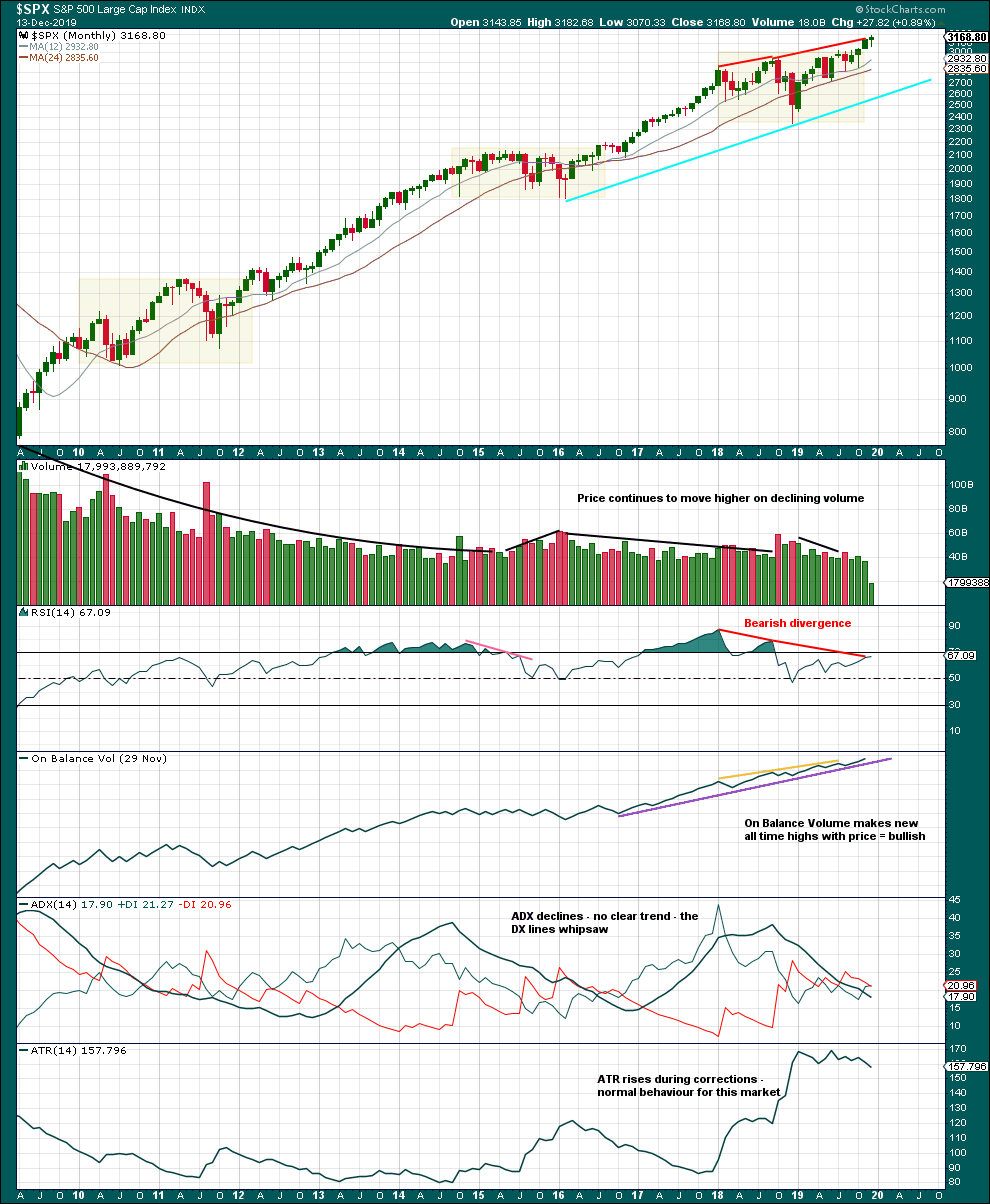
Click chart to enlarge. Chart courtesy of StockCharts.com.
There are three large consolidations noted on this chart, in shaded areas. After a breakout from a multi-month consolidation, it is reasonable to expect a multi month bullish move may result.
This chart very clearly exhibits rising price on declining volume has now persisted for several years. A decline in volume last month, in current market conditions, is not of concern.
On Balance Volume supports the Elliott wave count.
WEEKLY CHART
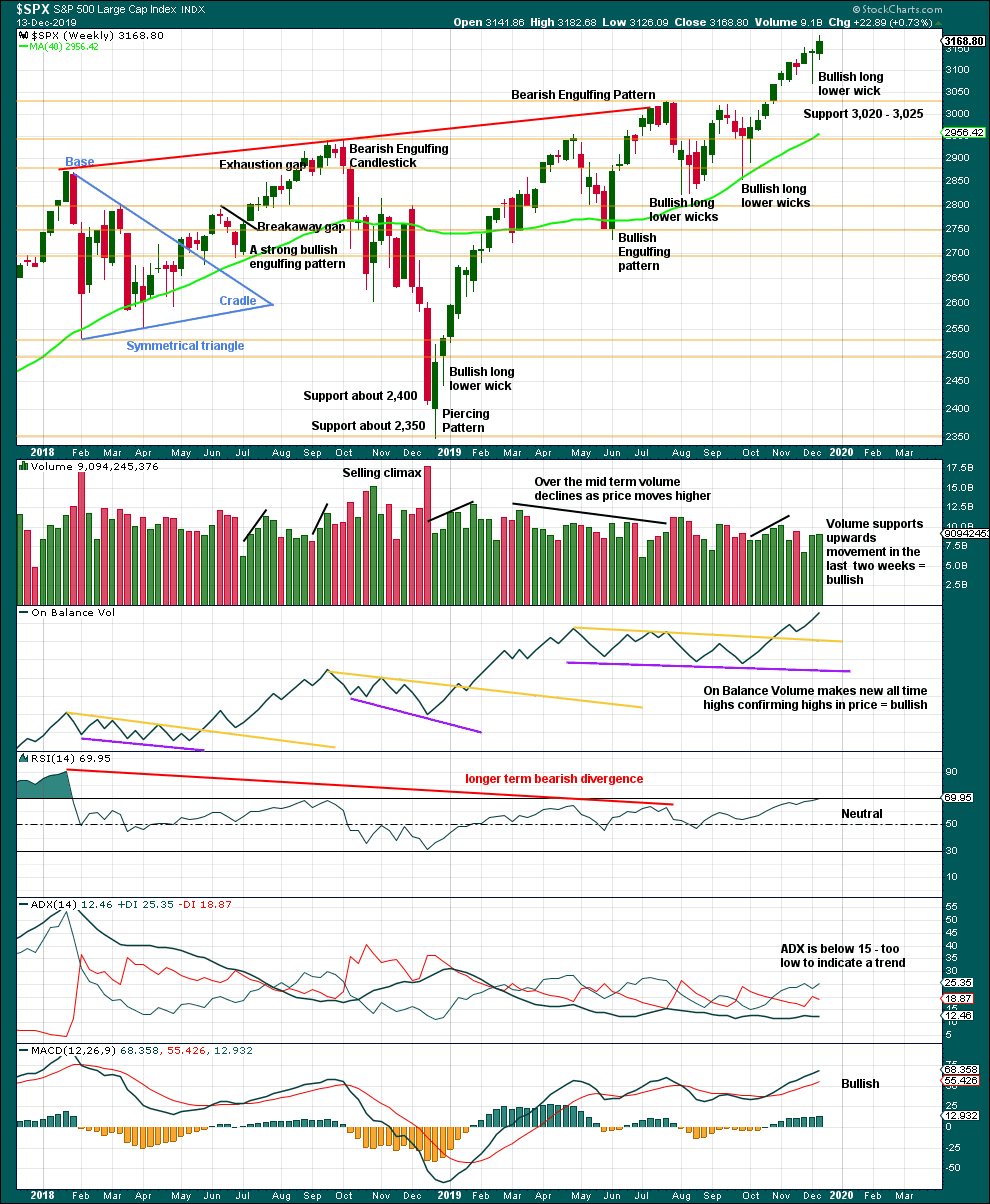
Click chart to enlarge. Chart courtesy of StockCharts.com.
It is very clear that the S&P is in an upwards trend and the bull market is continuing. Price does not move in straight lines; there will be pullbacks and consolidations along the way.
This chart is overall bullish. There are no signs of weakness in upwards movement.
DAILY CHART
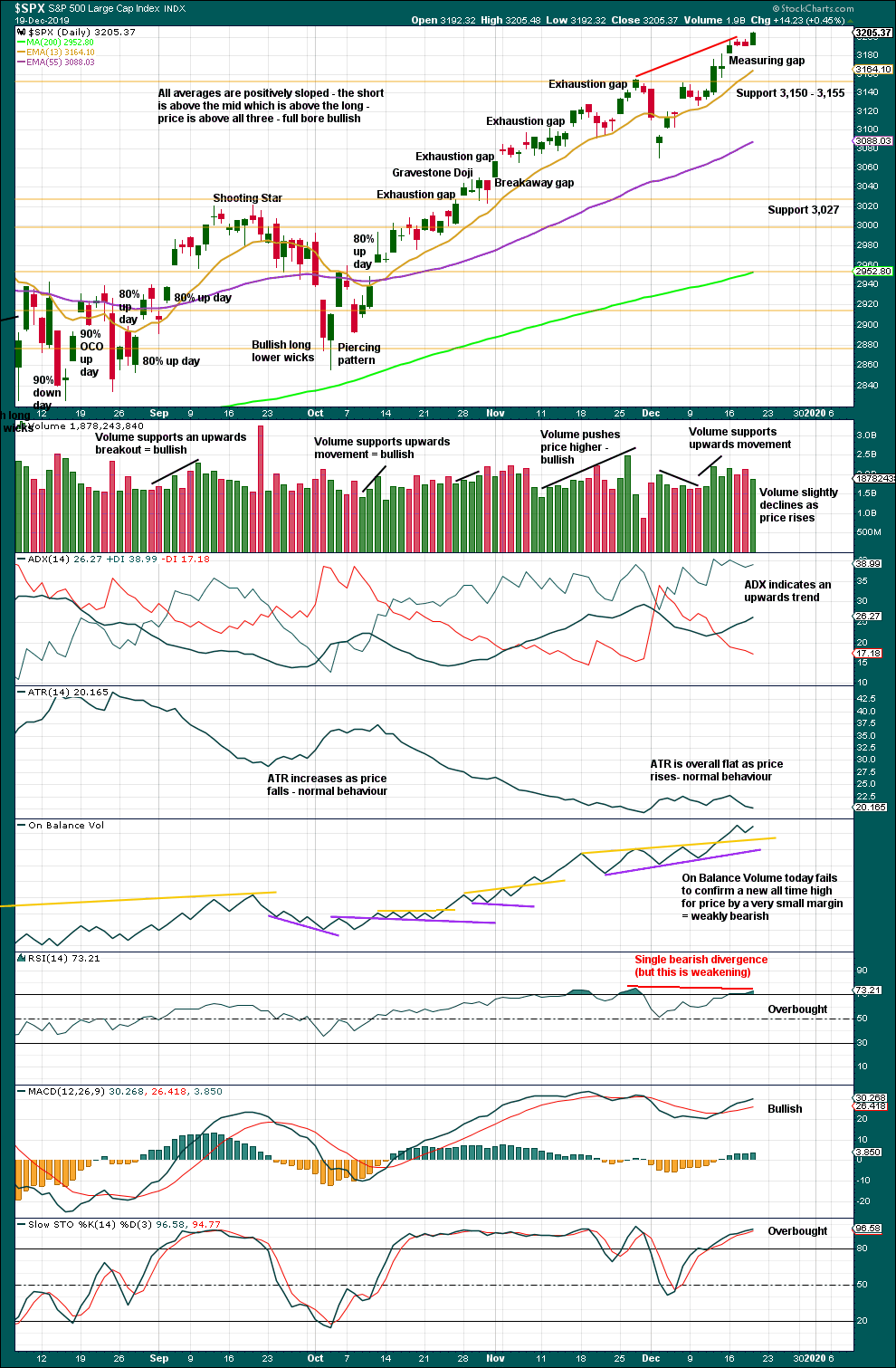
Click chart to enlarge. Chart courtesy of StockCharts.com.
There is an upwards trend in place. There will be corrections along the way.
Like the weekly chart, this chart is bullish. The only sign of weakness is divergence between price and RSI. This divergence is weakened. Occasionally, divergence between price and RSI develops and then disappears and is not followed immediately by a pullback. That could happen here, or the divergence may develop further to indicate a pullback to arrive.
The last gap is labelled a measuring gap, which it will be as long as it remains open. If it is closed, then it would be relabelled an exhaustion gap. This gap gives a target at 3,240 that is very close to the Elliott wave target at 3,238.
When this market trends, Stochastics may remain overbought for a very long time. Stochastics should be used to identify swings within a consolidation and not extremes of bull and bear trends.
An upwards session today with a close near the highs for the session suggests more upwards movement tomorrow. A decline in volume in current market conditions is not of any concern.
Conditions are again extreme with RSI overbought. This can be maintained for some time when this particular market has a strong bullish run, but it is an early warning that there will be a larger pullback to come. This market more often than not exhibits some weakness prior to a larger pullback, but not always. At this stage, there is very slight weakness in On Balance Volume and RSI. ADX is not yet extreme. There is room for this trend to continue.
BREADTH – AD LINE
WEEKLY CHART
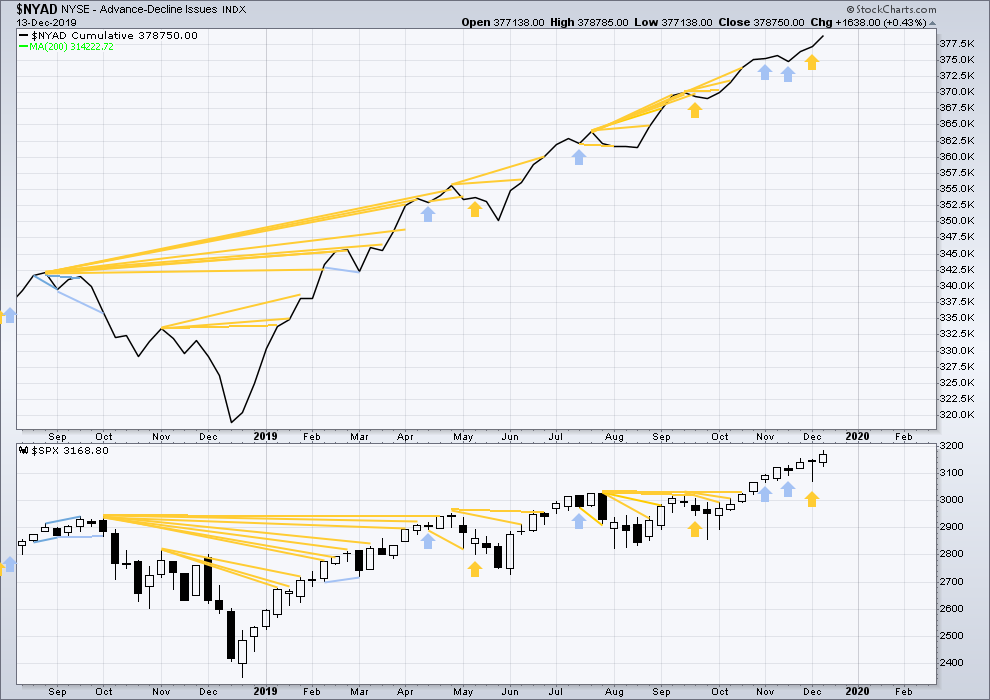
Click chart to enlarge. Chart courtesy of StockCharts.com. So that colour blind members are included, bearish signals
will be noted with blue and bullish signals with yellow.
Bear markets from the Great Depression and onwards have been preceded by an average minimum of 4 months divergence between price and the AD line with only two exceptions in 1946 and 1976. With the AD line making new all time highs last week, the end of this bull market and the start of a new bear market is very likely a minimum of 4 months away, which is mid March 2020.
In all bear markets in the last 90 years there is some positive correlation (0.6022) between the length of bearish divergence and the depth of the following bear market. No to little divergence is correlated with more shallow bear markets. Longer divergence is correlated with deeper bear markets.
If a bear market does develop here, it comes after no bearish divergence. It would therefore more likely be shallow.
All of small, mid and large caps have made new swing highs above the prior swing high on the 13th of September, but only large caps have made new all time highs. This upwards movement appears to be mostly driven by large caps, which is a feature of aged bull markets. This bull market at over 10 years duration certainly fits the definition of aged.
Last week both price and the AD line have made new all time highs. There is no divergence. Upwards movement has support from rising market breadth.
DAILY CHART

Click chart to enlarge. Chart courtesy of StockCharts.com. So that colour blind members are included, bearish signals
will be noted with blue and bullish signals with yellow.
Breadth should be read as a leading indicator.
On Friday price has moved higher but failed by a very small margin to make a new all time high. The AD line has moved higher to make a new all time high but only by a very small margin. This divergence is bullish, but it is weak.
Today again both price and the AD line have made new all time highs. Upwards movement has support from rising market breadth. This is bullish.
VOLATILITY – INVERTED VIX CHART
WEEKLY CHART
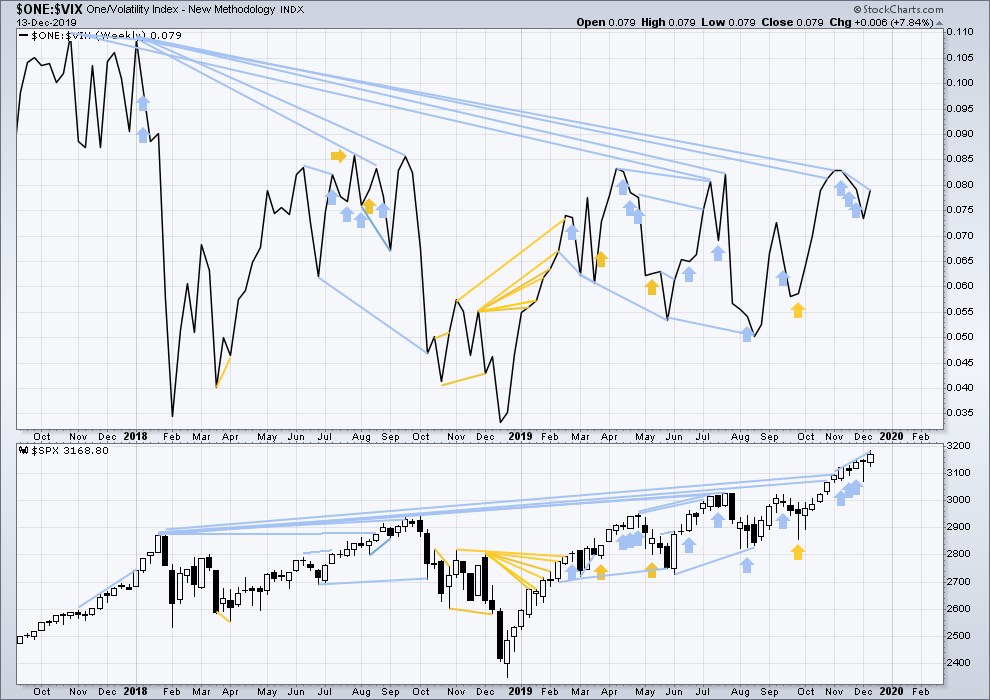
Click chart to enlarge. Chart courtesy of StockCharts.com. So that colour blind members are included, bearish signals
will be noted with blue and bullish signals with yellow.
The all time high for inverted VIX was on 30th October 2017. There is now over two years of bearish divergence between price and inverted VIX.
The rise in price is not coming with a normal corresponding decline in VIX; VIX remains elevated. This long-term divergence is bearish and may yet develop further as the bull market matures.
This divergence may be an early warning, a part of the process of a top developing that may take years. It may is clearly not useful in timing a trend change from bull to a fully fledged bear market.
Last week price has made new all time highs, but inverted VIX has not made new short, mid or long-term highs. Price has made a new high above the prior high four weeks ago, but inverted VIX has not. This divergence is bearish.
DAILY CHART
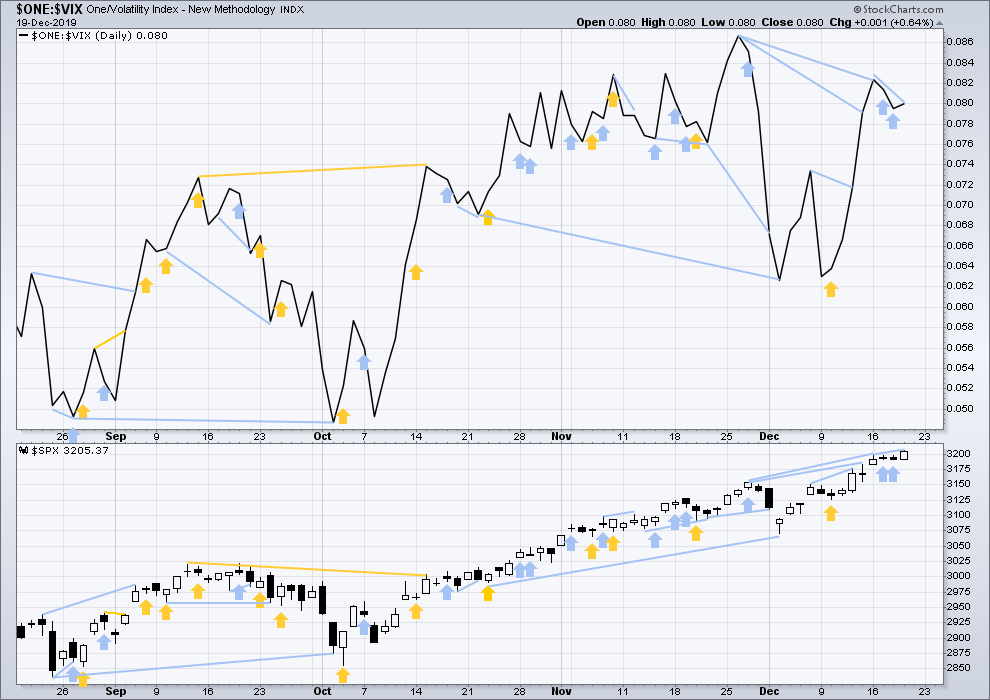
Click chart to enlarge. Chart courtesy of StockCharts.com. So that colour blind members are included, bearish signals
will be noted with blue and bullish signals with yellow.
Today both price and inverted VIX have moved higher. Price has made new highs, but inverted VIX exhibits all of short, mid and long-term divergence. This is another sign that a larger pullback may come. But this warning can be quite early, so it is given little weight in today’s analysis.
DOW THEORY
Dow Theory confirmed a bear market in December 2018. This does not necessarily mean a bear market at Grand Super Cycle degree though; Dow Theory makes no comment on Elliott wave counts. On the 25th of August 2015 Dow Theory also confirmed a bear market. The Elliott wave count sees that as part of cycle wave II. After Dow Theory confirmation of a bear market in August 2015, price went on to make new all time highs and the bull market continued.
DJIA: 23,344.52 – a close on the 19th of December at 23,284.97 confirms a bear market.
DJT: 9,806.79 – price has closed below this point on the 13th of December.
S&P500: 2,532.69 – a close on the 19th of December at 2,506.96 provides support to a bear market conclusion.
Nasdaq: 6,630.67 – a close on the 19th of December at 6,618.86 provides support to a bear market conclusion.
With all the indices having moved higher following a Dow Theory bear market confirmation, Dow Theory would confirm a bull market if the following highs are made:
DJIA: 26,951.81 – a close above this point has been made on the 3rd of July 2019.
DJT: 11,623.58 – to date DJT has failed to confirm an ongoing bull market.
S&P500: 2,940.91 – a close above this point was made on the 29th of April 2019.
Nasdaq: 8,133.30 – a close above this point was made on the 26th of April 2019.
Published @ 08:32 p.m. EST.
—
Careful risk management protects your trading account(s).
Follow my two Golden Rules:
1. Always trade with stops.
2. Risk only 1-5% of equity on any one trade.
—
New updates to this analysis are in bold.

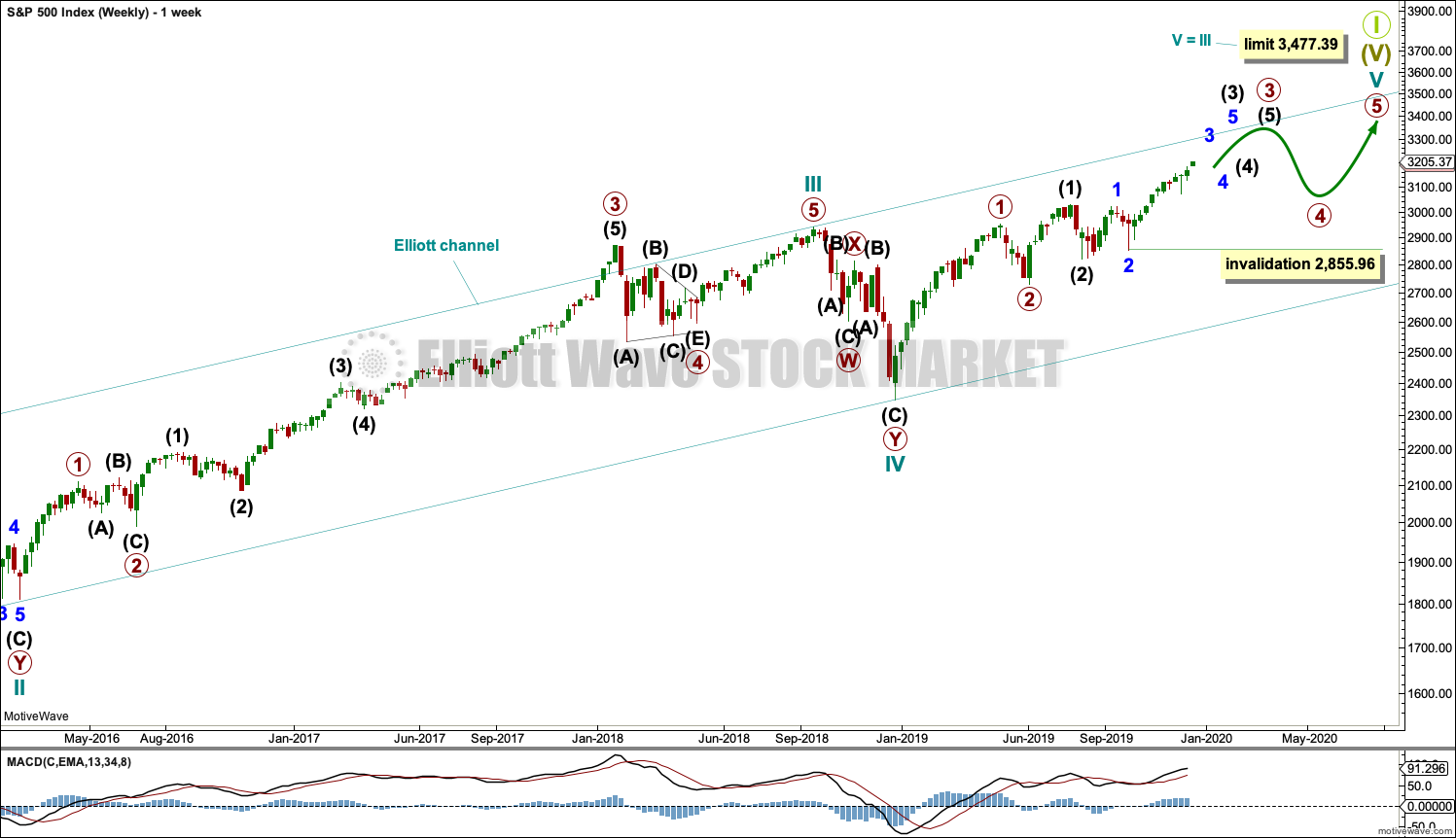
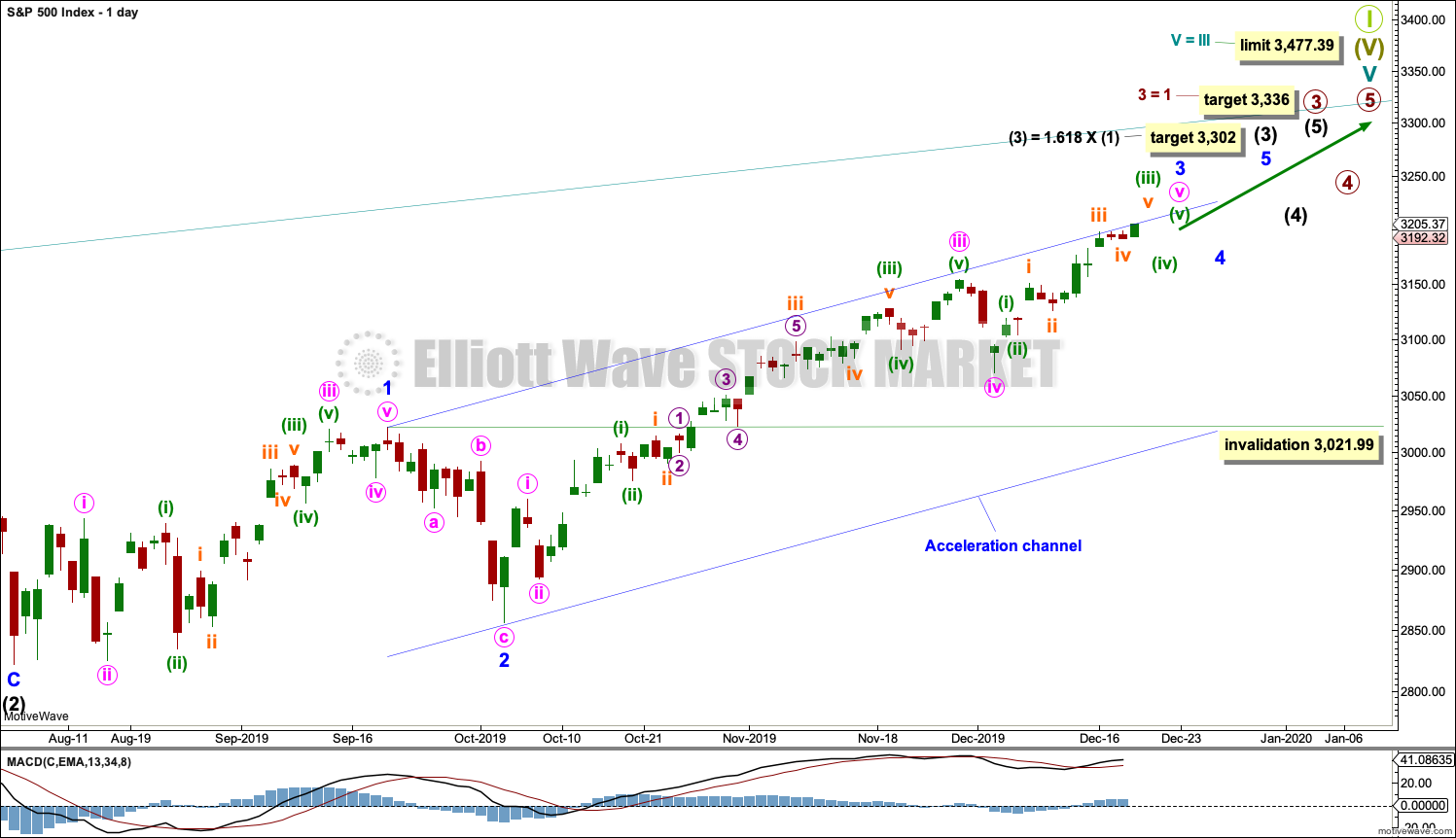
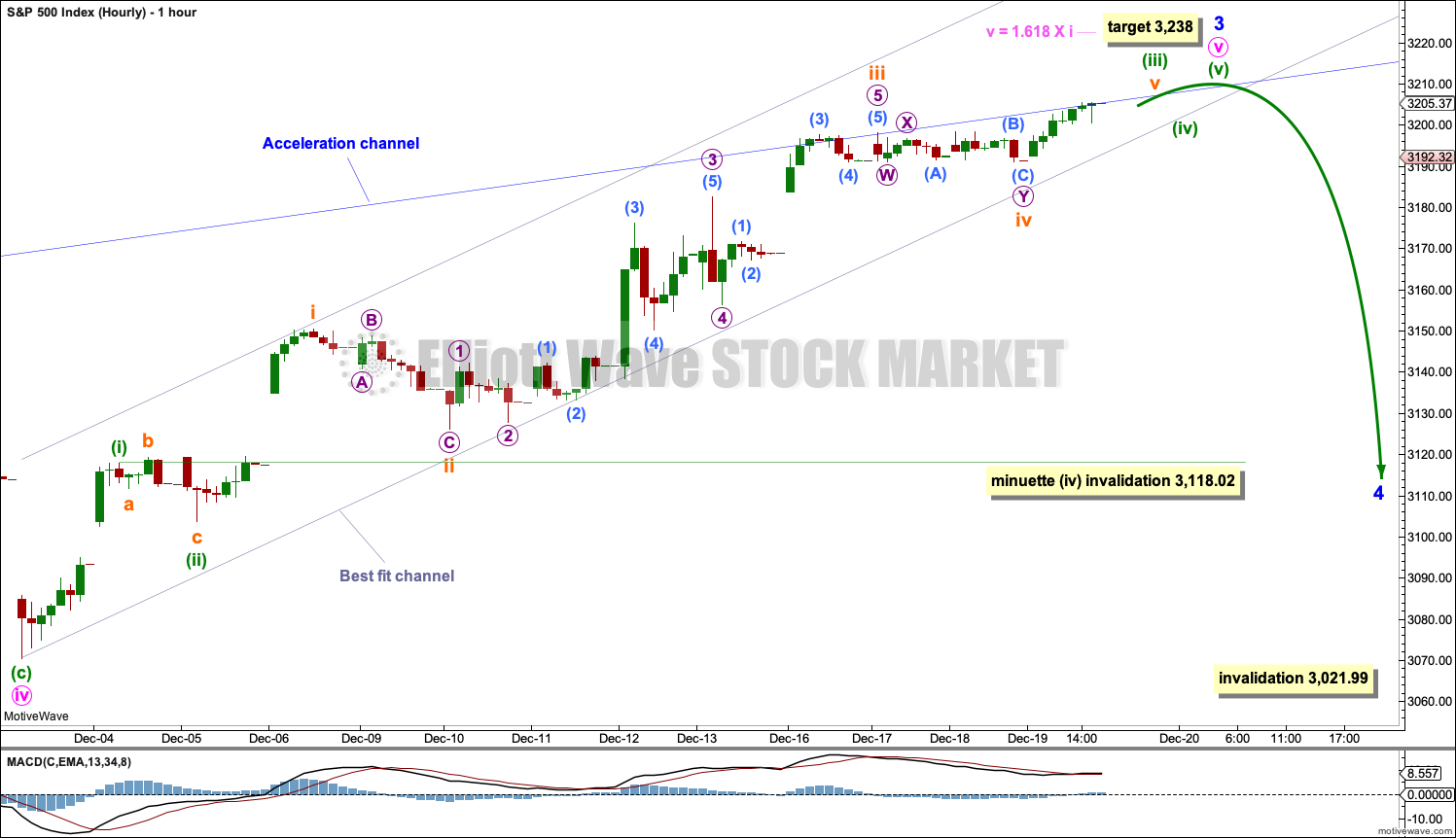
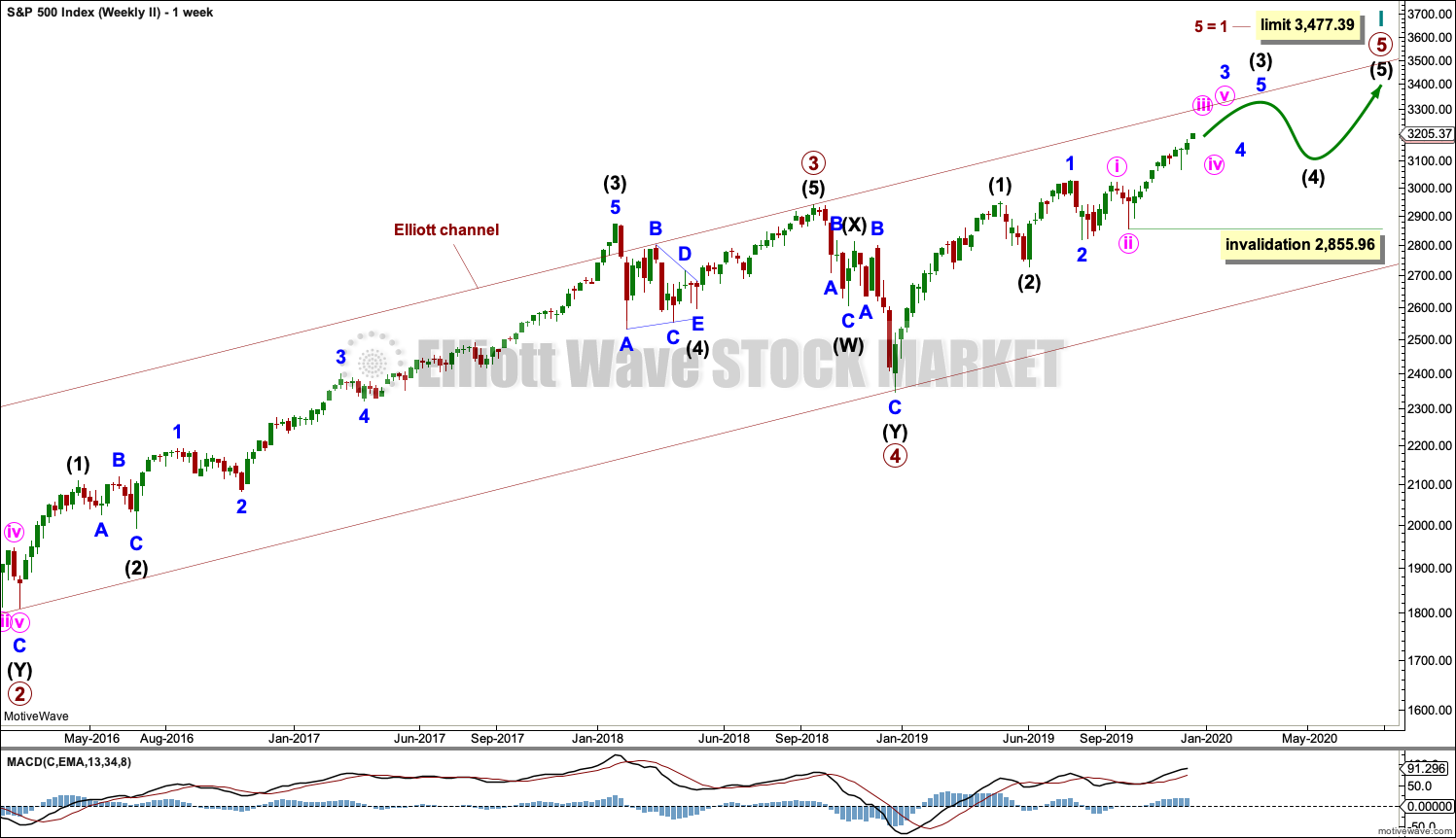
I have SPX just tagging the lower of my two overhead Fibonacci projections. If this one (which really is a range around the line; the precision of this method isn’t super high) doesn’t hold, then the next one is quite a ways up. And a minor 3 pivot high in between the two strikes me as possible…but not super likely, as that would leave the fractal structure of the overall minor 3 quite “messed up”.
Yep. It’s nearing its end, but I don’t think its quite there yet.
And onwards and upwards.
I’m going to label minuette (iii) within minute v now complete at todays high.
Minuette (ii) shows up on the daily chart but only as one red doji. Minuette (iv) may complete Monday and may be relatively brief and shallow.
Until minute v completes minor 3, I will still expect brief and shallow corrections.
Minor wave 3 may end next week.
Minor wave 4 may be relatively shallow in comparison to minor wave 3 though, but it may relieve extreme conditions.
Each day the risk of a sharp pullback to begin a sideways churn of a couple of weeks or so increases.
But it doesn’t mean it has to end here.
Risk management in extreme conditions is essential. The trend remains up, until proven otherwise.
Kevin,
I was looking further into RUT for it to make sense & how it can sync with SPX minor 4… so I labelled this minor 1 as leading diagonal with 5th wave overthrow…
So from EW rules, is there anything wrong with this count, as it is minute 1 of minor 3??
I don’t know. Seems a stretch honestly, trying to force what appears as impulsive action into a diagonal. But I suppose it’s possible.
My count has price in minute v of minor 3. 1700 is the next reasonable high potential pivot. Probably early-mid next week.
The bull force is VERY STRONG with these markets now!! Our minor 4 start just keeps shifting out and shifting out. The danger of course is we chase this market late and right as we get quite long…the minor 4 initiates. It’s never easy. On the other hand, today is options expiration and I’m closing out a very nice rack of sold put spreads for full profits, looks like I can pay bills in January hoo-ray!
Nice Job Kevin & Thanks for your feedback.
I was just wondering if it breaks any EW rules??
Maybe Lara can help if you get time to look at above count. Thanks
Well for all other counts it needs a lot of time & as you said this minor 3 keeps going strong, so minor 4 could still be days away and RUT completes all impulses but I was just looking at alternatives if it starts to roll over, as it has been the weakest market this year and still not showing any signs of flipping to stronger market, I think it could be outperform other markets in 2020
It appears all rules are met.
Check the wave lengths; iii must be shorter than i, and v must be shorter than iii. It’s pretty obvious that iv is shorter than ii and the trend lines converge.
But it doesn’t look right, it looks forced. The overthrow for a fifth wave of an ending diagonal should be much smaller than that. IMO I’d try another count and relegate that one to a low probability alternate.
Thanks Lara.
I’ll have another look.
The wave iii is longer than i by 12 points, do it’s incorrect.
Are the rules for leading of ending diagonal the same??
Nice open! This is what happens when a 3rd wave of several degrees manifests. I think we are witnessing the “Fear of Missing Out” crowd coming on board. There are no sellers. Thus, any buying pressure is causing the markets to rise. There are still billions and billions of dollars on the sidelines. In fact, relatively speaking it is one of the highest ‘cash on the sidelines’ on record.
Go bulls. Surprises to the upside continue. Have a great weekend everybody.
#1